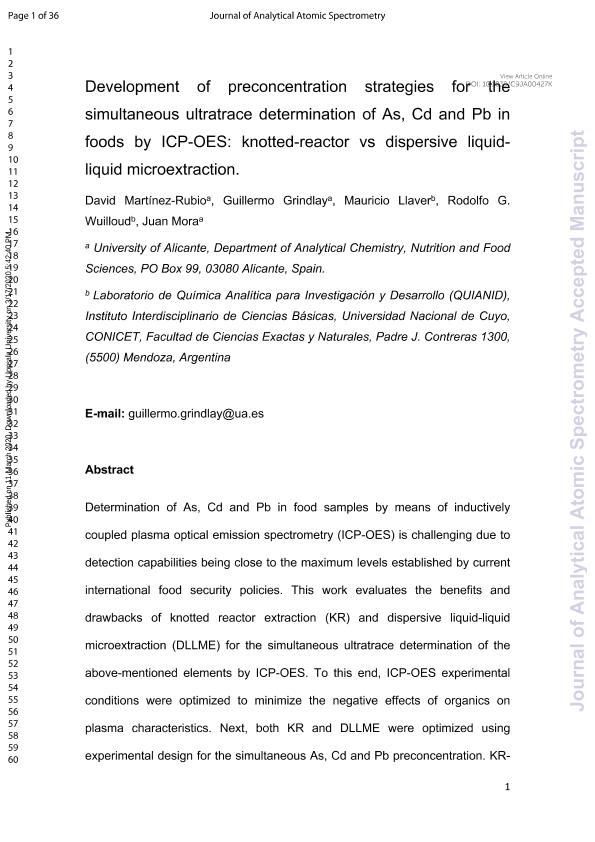Mostrar el registro sencillo del ítem
dc.contributor.author
Martínez Rubio, David
dc.contributor.author
Grindlay, Guillermo
dc.contributor.author
Llaver, Mauricio

dc.contributor.author
Wuilloud, Rodolfo German

dc.contributor.author
Mora, Juan
dc.date.available
2020-09-08T18:41:07Z
dc.date.issued
2020-03
dc.identifier.citation
Martínez Rubio, David; Grindlay, Guillermo; Llaver, Mauricio; Wuilloud, Rodolfo German; Mora, Juan; Development of preconcentration strategies for the simultaneous ultratrace determination of As, Cd and Pb in foods by ICP-OES: knotted-reactor vs. dispersive liquid–liquid microextraction; Royal Society of Chemistry; Journal of Analytical Atomic Spectrometry; 35; 5; 3-2020; 933-942
dc.identifier.issn
0267-9477
dc.identifier.uri
http://hdl.handle.net/11336/113541
dc.description.abstract
Determination of As, Cd and Pb in food samples by means of inductively coupled plasma optical emission spectrometry (ICP-OES) is challenging due to detection limits being close to the maximum levels established by current international food security policies. This work evaluates the benefits and drawbacks of knotted reactor extraction (KR) and dispersive liquid–liquid microextraction (DLLME) for the simultaneous ultratrace determination of the above-mentioned elements by ICP-OES. To this end, ICP-OES experimental conditions were optimized to minimize the negative effects of organics on plasma characteristics. Next, both KR and DLLME were optimized using the experimental design for the simultaneous As, Cd and Pb preconcentration. KR- and DLLME-ICP-OES methods were compared and applied to the analysis of different food samples, representative of the commodities regulated by the EU policy. Results in this work show that both KR and DLLME allow successful toxic element analysis in foods according to current EU policies. Nevertheless, DLLME is a more attractive approach than KR. First, DLLME allows the simultaneous determination of As, Cd and Pb, while KR is just limited to the last two elements, since As-complexes are not efficiently retained within the system. When compared to conventional ICP-OES analysis (i.e., no preconcentration), DLLME improves limits of detection (LOD) on average by 40-fold for As, Cd and Pb, whereas KR improves it by just 10-fold. For both methodologies, LOD improvement is derived from the preconcentration procedure as well as the beneficial effect of organics on aerosol generation and transport to the plasma compared to aqueous samples. Finally, DLLME affords higher sample throughput and consumption index than KR.
dc.format
application/pdf
dc.language.iso
eng
dc.publisher
Royal Society of Chemistry

dc.rights
info:eu-repo/semantics/openAccess
dc.rights.uri
https://creativecommons.org/licenses/by-nc-sa/2.5/ar/
dc.subject
METALS
dc.subject
FOOD ANALYSIS
dc.subject
KNOTTED-REACTOR
dc.subject
DISPERSIVE LIQUID-LIQUID MICROEXTRACTION
dc.subject.classification
Química Analítica

dc.subject.classification
Ciencias Químicas

dc.subject.classification
CIENCIAS NATURALES Y EXACTAS

dc.title
Development of preconcentration strategies for the simultaneous ultratrace determination of As, Cd and Pb in foods by ICP-OES: knotted-reactor vs. dispersive liquid–liquid microextraction
dc.type
info:eu-repo/semantics/article
dc.type
info:ar-repo/semantics/artículo
dc.type
info:eu-repo/semantics/publishedVersion
dc.date.updated
2020-06-30T14:15:30Z
dc.journal.volume
35
dc.journal.number
5
dc.journal.pagination
933-942
dc.journal.pais
Reino Unido

dc.journal.ciudad
Cambridge
dc.description.fil
Fil: Martínez Rubio, David. Universidad de Alicante; España
dc.description.fil
Fil: Grindlay, Guillermo. Universidad de Alicante; España
dc.description.fil
Fil: Llaver, Mauricio. Universidad Nacional de Cuyo. Facultad de Ciencias Exactas y Naturales. Laboratorio de Química Analítica para Investigación y Desarrollo; Argentina. Consejo Nacional de Investigaciones Científicas y Técnicas. Centro Científico Tecnológico Conicet - Mendoza. Instituto Interdisciplinario de Ciencias Básicas. - Universidad Nacional de Cuyo. Instituto Interdisciplinario de Ciencias Básicas; Argentina
dc.description.fil
Fil: Wuilloud, Rodolfo German. Universidad Nacional de Cuyo. Facultad de Ciencias Exactas y Naturales. Laboratorio de Química Analítica para Investigación y Desarrollo; Argentina. Universidad Nacional de Cuyo. Facultad de Ciencias Exactas y Naturales. Laboratorio de Química Analítica para Investigación y Desarrollo; Argentina
dc.description.fil
Fil: Mora, Juan. Universidad de Alicante; España
dc.journal.title
Journal of Analytical Atomic Spectrometry

dc.relation.alternativeid
info:eu-repo/semantics/altIdentifier/doi/http://dx.doi.org/10.1039/C9JA00427K
dc.relation.alternativeid
info:eu-repo/semantics/altIdentifier/url/https://pubs.rsc.org/en/content/articlelanding/2020/JA/C9JA00427K#!divAbstract
Archivos asociados
